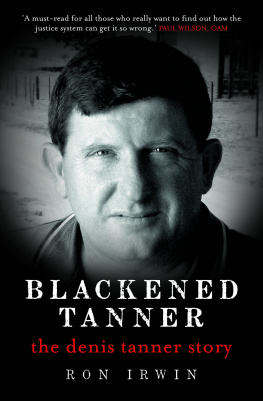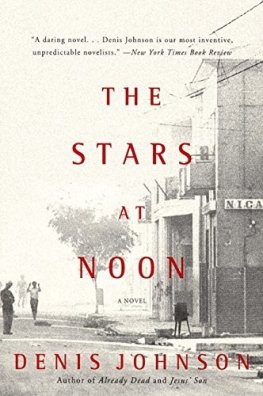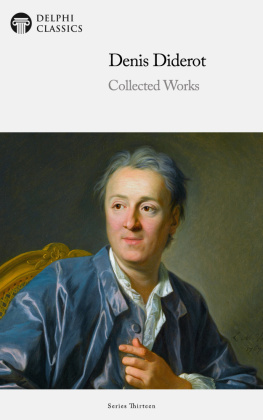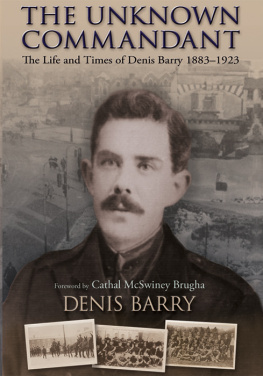Abbreviations
CCR: Telephone Call Charge Record
D24: Police radio control centre
Dogs: Surveillance police
DPP: Director of Public Prosecutions
DSG: District Support Group
ESD: Ethical Standards Department
FOI: Freedom of Information
OPI: Office of Police Integrity
VCAT: Victorian Civil and Administrative Appeals Tribunal
Authors Acknowledgements
I must acknowledge the contribution of the Tanner family. The Tanner parents, Fred and June, simply couldnt understand why this happened to their family when the alien world of police, smart lawyers and journalists intruded into their lives. This very ordinary Australian family never faltered in encouraging me.
When it comes to good blokes, Laurie Tanner is the best. His enduring love for Jennifer still touches me; it remains a private love from a very private man. He knows that his wife took her life, and he has one purpose in his: to protect his son and grandchildren from further hurt.
Denis Tanner, in his endless quest for a normal life, trusted me with everything he could get his hands on. He and his family have never deserved the public mockery that this travesty has inflicted on them. I hope that their burden eases with the publication of their side of the story.
Gerry McHugh and his family endured hell at Mildura after he was falsely accused of complicity in the murder of Adele Bailey. Their silence was bought, their story was hidden, but I knew the story well, so it had to be told.
Former detective Gordon Davie spent several months living with us, dissecting evidence and developing a reference system to help me get started. He has loyally stayed with me to the point of publication. Various retired police officers have trusted me to tell their stories, including Ian Welch, Jim Fry, Tom OKeefe, Bill Fraser, Neil Walker and Peter Mangles, all of whom tried to sort out faults not of their making in 1984 and 1985, and whose reputations were unjustly besmirched during the second Jennifer Tanner inquest.
The staff of former State Coroner Graeme Johnston was always prompt and helpful. Author Robin Bowles exchanged information with me. Her books and her intimacy with the Kale Taskforce provided me with firsthand knowledge of a warped police mindset.
Melbourne University academic, lawyer and author Jude Wallace, psychologist and barrister Professor Don Thomson and criminologist Professor Paul Wilson all volunteered valuable advice. Former homicide squad heads Carl Mengler and Peter Halloran willingly studied my drafts and added their own assessments of the evidence. Author Michael Gilchrist volunteered unexpected assistance with structure and editing of my draft manuscript.
Publisher Poppy Grijalbo, commissioning editor Julia Taylor from The Five Mile Press, editor Jenny Lee and lawyer Nic Pullen lifted my spirits enormously with their enthusiasm and professional advice.
Melbourne barrister Brian Bourke, once my fierce opponent in the courts, volunteered valuable legal advice whenever it was needed.
My own family deserves special mention. They have missed my attention because an intended six-month project turned into an unexpected ten-year marathon. My wife Vi shouldered the burden. She worked long hours running our business and caring for me during my ten years of disability. Without her patience and self-sacrifice, this book could never have been written.
Appendices
Appendix A: Summary of the observations in the statements of all who attended Jennifer Tanners death
There was a television in the near right-hand corner; ambulanceman Gerry ODonnells sketch shows it as being turned off, but his statement said it was on.
A gas heater was centrally located along the right-hand wall.
There was an ironing board and with an iron standing on it situated near the heater.
On the floor under the ironing board was a soiled disposable nappy and a tin of baby powder. (The police statements are obviously wrong because Jennifer didnt use disposable nappies; this point was corroborated by Jennifer in her conversation with Angela McCormack on the same night, by her mother in a later taped conversation with Kerr, and by June and Laurie Tanner.)
Kerr and Fraser say that on the far side of the heater there was a cup and saucer and a small plate with two or three biscuits, but in a statement taken by Fraser two days later (16 November 1984), Dr Gilham described these objects as a cup and a biscuit barrel.
There was also an ashtray on a nest of three coffee tables with cigarette butts and a single cigarette with the ash intact that had burnt its entire length in the ashtray.
There were two fresh nappies and a babys bottle on the floor immediately in front of the deceased; they werent disturbed or upset.
Jennifer was seated in a slumped-back position on a two-seater couch in front of the window of the far (north) wall.
The head was tilted forward and to the left of the body.
The right leg was straight out, the left leg bent with the left foot on the floor approximately under the right knee joint.
The feet were bare. Moccasins and socks were on the floor beside her.
The right arm was extended down on the right side of the body, with the palm of the hand over the stomach, just below the navel.
The left arm was extended down the left side, with the elbow bent, resting on the seat of the couch; the hand had the thumb and index finger partially wrapped around the barrel of a .22 Brno rifle, which was pointing toward the ceiling and resting on the front of the wooden stock.
The top button of her jeans was undone with the zip partly open; this was something that she normally did if she didnt have visitors.
The butt of the rifle was resting on the floor between her legs, to the rear of her left heel, with the barrel furthermost from the body.
There was a white bath towel on the left side of the seat of the couch; it was heavily bloodstained and had what appeared to be two powder-burn markings on it.
There were bloodstains on the back of the couch behind the head of the deceased and down the left side of the head onto the back cushion.
There was a large amount of congealed blood along the left hip and upper leg in the seat cushion caused by the depression of the body.
There were other bloodstains (spatters) along the length of the couch.
A square cushion on the far end of the couch, to the left of the body, was lightly bloodstained as though something had been wiped across it to remove the blood.
There was a wound in the centre of the forehead.
On the floor near the butt of the rifle, behind her left heel abutting the couch, was a spent .22 cartridge case.
The rifle was a .22-calibre Brno rifle of bolt action with a ten-bullet magazine feed.
There were two live hollow-point bullets in the magazine.
On opening the breech, Kerr ejected a spent cartridge.
There were bloodstains down the length of the rifle from the muzzle to the butt, inside the trigger guard and on the face of the trigger.
There was a droplet of blood on the lens of the telescopic sight.
The lower extremities of the body were showing post-mortem lividity a bluish, bruised colouring and the upper part of the body was pale, yellowish and without colour.
There were wounds to the fleshy part of the webbing between the thumb and forefingers of each hand.
Her infant son, Samuel, was asleep in the bedroom across the hall from the lounge room.
Fraser later made further observations on Andrew Rules SBS documentary:
The blood at both ends of the couch was smeared, indicating that Jennifer had gone from both ends of the couch, as though she had laid down at one stage and then sat up in a manner indicating that process had gone on for a while.
Ambulance driver ODonnell made this observation in his police statements and inquest evidence:
Next page






